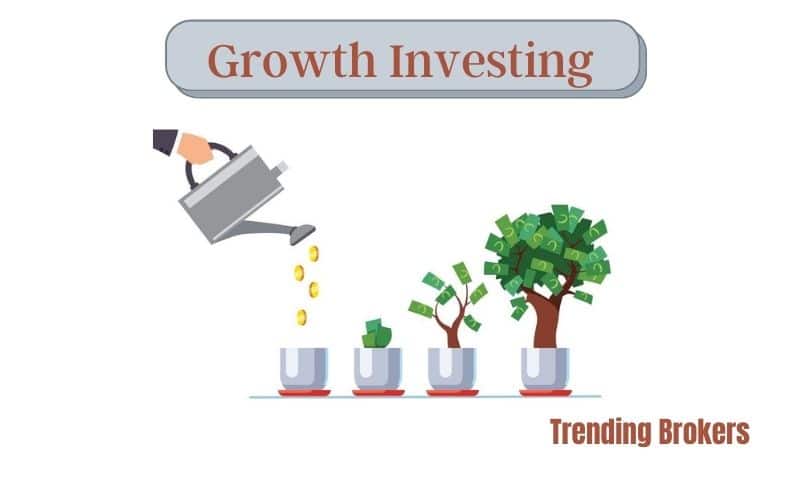Growth investing is referred to the investment strategy that considers capital appreciation. The main focus of the investor is to enhance the capital. This is in contrast to value investing, which promotes capital preservation above short-term capital gain. Growth investment takes into account both a company’s current financial status and its potential for future growth.
It clearly indicates that the primary motivation for investors to place their money in stocks is to increase their returns. But, of course, this is only achievable if the proper technique is employed while bidding on the funds. But traders have to be aware that there isn’t a one-size-fits-all hero approach, and there are hundreds upon dozens of stock market investment techniques to choose from.
Growth Investing is one such approach, and it is one of the most popular among investors looking to make a profit. Traders who are solely concerned with strong stock price movement in a specific direction, regardless of the underlying fundamentals, are just speculative investors. Growth investment is distinguished from pure speculative investing by its focus on the present and future.
Because growth stocks may be unpredictable, being able to look at a company’s financial situation objectively can help you determine if a recent upturn is worth following or if a recent fall is a buy the dip opportunity. Of course, all investment involves some level of speculation. After all, if every stock could be predicted perfectly, everyone would be a successful investor.
What is Growth Investing?
Growth investing is a strategy in which the primary goal is to expand the capital of the investor. The money is put into stocks of tiny and new firms whose profits are predicted to rise at a specific rate under this method.
Stocks of younger firms whose profits are predicted to grow at a faster rate than the industry or general market are purchased in the Growth Investing approach.
When we hear the term investment, we automatically think of danger. However, the risk associated with the Growth Investing method is substantial since it entails purchasing from new and tiny businesses. The high risk is due to the fact that these firms have not been tested because they are new.
On the other side, if the firms outperform their industry, there’s a considerable probability they’ll be able to earn bigger returns in the near future.
Tips of growth investing
There’s no way to know if you’ll regularly earn money with growth investing, but there are a few things you can do to improve your chances.
Diversify: Diversification is a fundamental technique in growth investing, just as it is in general investing. A well-balanced and well-maintained stock portfolio will boost your reward exposure while lowering your risk exposure. When investing in growth, diverse firms, industries, size, and liquidity, investors should maintain a diversified exposure. In addition, these holdings should have their position sizes reviewed by investors since they might bring disproportionate risk to the entire portfolio.
Spread your capital in global markets: A wise growth investor considers international and emerging markets as well as a variety of asset types other than stocks when allocating resources. Investors should maintain a balance of local and international investments, as well as other assets such as fixed income and cash, in their portfolios to offer ballast when market volatility strikes and risk assets such as equities fall in value.
Market Potential: The IT sector is one area where growth stocks are king. The fundamental reason for this is that the tech industry develops disruptive products virtually by default, allowing its producers to gain market domination.
Growth stocks generally trade at a premium to the market for a variety of reasons, including more significant profit growth, a distinctive product or business model, or industry dominance.
Patience: Diversification is vital, but few of us have the time or money to personally select hundreds of equities. As a result, an ETF or mutual fund is usually the best method to diversify.
It’s crucial to remember, though, that after you’ve found a decent fund, you’ll have to wait. Most of the best-performing growth funds have good returns in the medium and long term, but you may have to wait a year or two to realise big gains. This is especially true in the case of growth investing, as several well-known growth businesses, such as Tesla, took years to break even.
Research is essential: If you want to have a good sense of what to expect from growth investing, you’ll need to do some research. This entails not just thoroughly examining the fundamentals of every firm in which you intend to invest but also keeping an eye on the broader economy for evidence of a good climate for growth investment, such as low-interest rates.
This last aspect is crucial. When specific economic circumstances are satisfied, growth stocks may be more likely to increase or fall, with low-interest rates, for example, being an essential signal of a broader desire for equities.
Fundamental Analysis
This is also referred to as doing your homework. Fundamental research indicators such as price-to-earnings or price-to-book ratios are used by successful growth investors. However, if the firm looks to be capable of delivering above-average growth, investors may be prepared to buy the stock even if these measures indicate that it is expensive.
Risk Appetite
Growth investors are more willing to take risks than value investors. Growth investment, on the other hand, has a place in nearly every investor’s portfolio. Growth investing is one of the only methods for investors to maximise their gains in a bull market and help to balance their losses in a bear market, despite the risk of some loss.
How to choose growth investing companies?
There are a plethora of fresh and small developing businesses, but which are the greatest candidates for expansion capital?
If you want to assess a growth stock’s potential, you must examine and comprehend the company’s subjective and objective variables. Of course, personal judgement and gut feeling are also important considerations; gut feeling adds value to growth stocks, but other purchases should be based on logic rather than emotion.
You can think about a couple of the variables listed below.
Historical Growth
Despite the fact that the businesses are tiny and new, historical growth is one of the determining variables. A growth investor might check for the company’s growth during the last few years in small businesses. You might not want to invest if the firm is not growing significantly.
Profit Margins
When considering a firm for growth investing, it is critical to analyse the pretax profit margin. We prioritise profit over sales since a company’s sales statistics may be impressive, but its earnings or revenue numbers may be less so. If the company’s earnings are lower despite a large number of sales, it has serious difficulty managing revenues and reducing expenses. Therefore, when compared to the previous five years, it is deemed the greatest if the firm exceeds the average pretax profit margin.
Return on Equity
One of the most crucial considerations is how much income the firm has created with the money invested by shareholders. Divide the net income by the shareholder equity to arrive at this figure. Comparing this value to statistics from the previous five years is the ideal technique; if the figures are stable or higher, the firm is functioning well.
Forward Earnings Growth
A corporation publishes a public declaration of its profit for a specified period every quarter or year. These figures are helpful for determining whether or not the company is profitable and functioning well. In addition, they assist investors in determining whether businesses are expected to grow at rates higher than the average and existing rates. These public announcements are issued on specified occasions during the quarter or year.
Stock Performance
If a business’s stock is performing well and is expected to double in the next 5 to 7 years with at least 10% growth, it might have a significant impact when choosing a growth investment firm. This could be a hint that a company is a suitable fit for growth investing.
Examples of Growth Stocks
The fundamental criterion for determining whether a stock is a growth stock is that it is increasing as a result of its core business operations. Cost-cutting and other accounting tactics can help certain businesses demonstrate growth. An actual growth stock, on the other hand, will represent a company that is growing revenue and earnings organically.
A stock can also change from a growth stock to a value one and vice versa. Disney (DIS), for example, did not qualify as a growth stock for many years. However, in addition to paying a dividend, the company has become one of the strongest growth stocks since 2010. Another point arises as a result of this.
Dividend from growth stocks
When a business is in growth mode, a portion of its capital is used to keep the business going. Unfortunately, this is at the expense of strategies such as paying a dividend to shareholders directly. Growth investors, on the other hand, are willing to overlook the lack of a dividend if the company meets its growth plans.
In some situations, though, a corporation can accomplish capital growth while still being able to pay a dividend. These are often referred to as forever stocks since they appeal to both growth and value investors.
Bottom Line
Capital appreciation takes precedence over capital preservation and the possibility of receiving a dividend for growth investors. Growth investing, on the other hand, is a strategy that any investor can use at some point in their career. Moreover, the overall trend for stocks has been good over time. So, if you forgo growth investing entirely, you’re denying yourself the chance to gain dramatically.
You can invest in growth stocks through a reliable and well-equipped broker like Investby. The brokerage firm offers growth stocks from various global markets and CFDs on multiple asset classes.
Growth investing is a strategy in which the primary goal is to expand the capital of the investor. A growth investor puts money into startups or small businesses that are likely to multiply in the near future. Given its concentration on companies that are displaying evidence of above-average expansion and profitability, growth investing allows investors to outperform the market.


